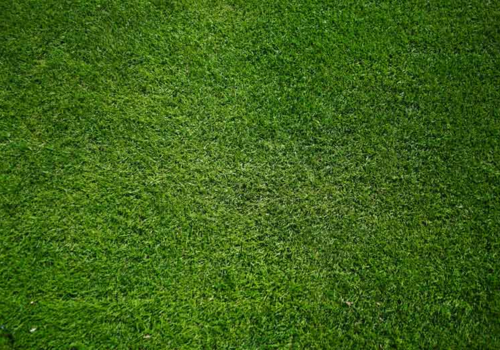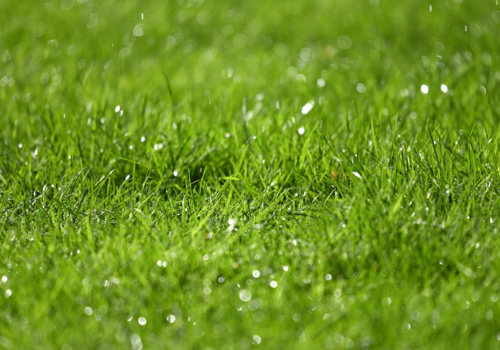
In this blog, we cover all of our top August lawn care tips for the summer season.
As you continue to enjoy your lawn due to the good weather August brings, it's important to stay on top of lawn care tasks. Keep mowing and feeding based on the lawn care schedule you developed over the typically warmer summer months of June and July, but also use August to prepare your lawn for the upcoming autumn months of September and October.
Let us guide you through the tasks that will help you make the most of your summer lawn before the cooler weather sets in, so you can move into autumn with healthy turf.
What should I do to my lawn in August?
Here’s your August lawn care ‘to-do’ list:
- Regular mowing
- Feed if required
- Aerate compact areas
- Weed control
- Scarify
- Overseeding
Mowing your lawn in August
Continue to cut the grass as you have done throughout the summer, around every 1–2 weeks. Keep mower blades high to avoid drying it out. Mow the lawn regularly so you can keep things tidy whilst avoiding cutting too short. Getting this right is one of the most important parts of lawn care - balancing growth and moisture levels.
Consider sharpening your mower blades if you’re not achieving a clean cut. It’s not worth the risk of tearing the leaves whilst mowing, so if the summer has left your lawnmower a little tired, don’t forget to do some basic maintenance.
Can you fertilise the lawn in August?
Yes, you can fertilise your lawn in August. It’s best to stick with a summer feed at this time of year, moving to an autumn lawn fertiliser from September onwards.
This month, continue your lawn feed schedule by applying fertiliser every 6–8 weeks. Our spring and summer lawn fertiliser will provide the nutrients you need to keep a healthy lawn. If you’ve kept on top of applying fertiliser since early spring, you should be enjoying a robust summer lawn.
Can I scarify my lawn in August?
Yes, you can scarify your lawn in mid to late August. It’s best to scarify late in the summer or early autumn. At this time of year, your lawn should be both warm and moist enough for the grass to recover well.
Make sure you remove any thatch and use it for compost to improve the rest of your garden. Finish by overseeding with a suitable grass seed where necessary, and use a top dressing to help your lawn recover.
Why scarify my lawn?
There are plenty of benefits associated with this process. It can help to remove dead weeds and moss, allowing both water and nutrients to reach the grass plants. You’ll improve your overall lawn health and reduce the chance of moss problems in the future. It’s also great preparation for overseeding.
Sowing Grass Seed in August
Late summer is a good time to plant grass seed, as the conditions are ideal for germination. Overseeding will help repair bare patches caused by high traffic and the heat of summer.
It’s ideal to overseed when you’ve removed debris and prepared the soil. It can be helpful to apply a pre-seeding fertiliser a few days before planting grass seed, too. Try our lawn repair grass seed to renovate damaged and patchy lawns.
Don’t forget that newly sown lawns need plenty of moisture, so if there’s little rain, you might need to set up a watering schedule too.
How to Keep Your Lawn Healthy in Late Summer & Early Autumn
There are a few specific challenges that your lawn can face in the summer months and into the autumn. You’ll need to be aware of these to keep your lawn healthy and lush.
Of course, warm and dry weather can still be a concern during August. Check our July lawn care advice for more information on watering your lawn to keep the grass in tip-top condition.
August can be a heavy-use month for your lawn, with school holidays and hot days making the garden a busier place than usual. Pressure on the surface of your lawn from feet, garden furniture and toys can compact the soil. Make sure you aerate these high-traffic areas, as even established lawns will suffer under this kind of pressure.
Common Mistakes to Avoid in August Lawn Care
Even the most dedicated gardeners can make mistakes that impact the health and appearance of their lawn. We’ve listed the common mistakes below to ensure you keep your lawn healthy and thriving.
Not Watering Deep Enough
One common error is not watering deeply enough. Shallow watering encourages weak roots, making your lawn more vulnerable to drought and disease. Instead, water thoroughly to help roots grow deep into the soil.
Irregular Mowing
Another pitfall is neglecting to mow regularly. Allowing grass to grow too long can lead to uneven growth and give weeds a chance to take hold. Make sure to mow regularly, keeping your lawn tidy and healthy.
Over-Fertilising
When it comes to lawn fertilisers, using the correct quantity is key. Over-fertilising can scorch your grass, while under-fertilising may result in poor growth. Always follow the recommended guidelines for your chosen product.
Ignoring Regular Maintenance Tasks
Leaving weeds and debris on the lawn can create an environment where pests and diseases thrive. Regularly remove weeds and rake away leaves or other debris to keep your lawn in top condition. It’s also important to consider your lawn’s specific needs, such as soil type and intended use, when making lawn care decisions.
Using the Wrong Grass Seed Mixture
Choosing the wrong grass seed mixture for your garden can lead to disappointing results. Different grass species have unique requirements, so select a seed that matches your soil and the conditions in your garden. Before sowing, prepare the soil thoroughly to ensure good seed-to-soil contact and successful germination. Finally, newly sown lawns need consistent moisture and adequate light to establish well — don’t let them dry out or become shaded by overhanging plants.
By avoiding these common mistakes, you’ll create a strong, healthy lawn that looks great all year round.
Extra August Lawn Maintenance Tips
Keep your lawn healthy with these additional lawn care tips:
Weed Control
August is a good time to apply weed treatments to the whole lawn. You can also wait until September to do this if you have a weed problem. If you’ve kept on top of weeds throughout the summer, it’s best to continue with manual removal.
Moss
As moisture levels increase and the ground becomes damp, you may start to see moss return as you move towards autumn. Get ahead of this problem now by raising mower blades for a longer leaf, and aerating the lawn for better drainage. Thin out plants or trees that are creating shade so the ground in these areas doesn’t stay too wet. Prevention is ideal, as you’ll need fewer chemical treatments on your lawn.
Worms
You might notice a return of worm casts as damp weather increases. This is a sign your lawn is healthy but can be a problem when mowing. Brush worms cast back into the lawn to create an even surface.
Congratulations on keeping on top of your lawn care during the spring and summer months! As we move into autumn and the weather changes, your lawn care tasks will need to adapt too. Make sure you keep up with our lawn care diary for the colder months to keep your lawn healthy and happy all year round.
For more help and advice on lawn care throughout the year, check out our monthly lawn calendar. It’s full of advice for spring, summer, autumn, and winter care. Or, if you're looking for some lawn care tips for the coming months, take a look at our next lawn care guides:
How we can help!
At Boston Seeds, we take pride in excellent customer service. If you're growing a lawn from scratch but unsure how much grass seed you need, our handy Grass Seed Calculator can help you figure it out in just a few clicks!
With Next Day Delivery on hundreds of items too, choosing from our extensive range of grass seed couldn't be easier. Ordering regularly or looking for large volumes? Click here to apply for a trade account today — we review all applications within one working day. If you have any questions, then please get in touch.


